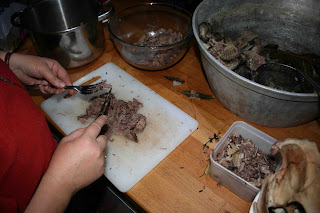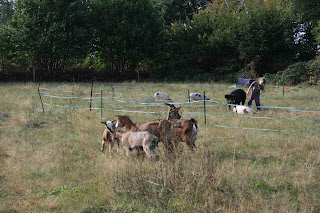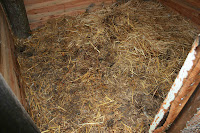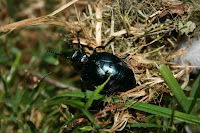This blog so far has been written by me, Alison, but as I wasn't involved in most of this morning's activities, here is Ben's account....
I'm not a vegetarian.
Since I could toddle I've been an active and vociferous meat eater. Every Thursday after my cruel and heartless parents forced me to go to Silver Band practice (run by Mr Phillips, a sadistic conductor who would throw his baton at you when you made a mistake) the only thing that would keep me going was the thought of being allowed to go to Burger King afterwards to pick up a takeaway Double Whopper with cheese. However, since running the farm here in France I became aware that perhaps to hold my head high as a meat eater I needed to "man up" and actually get involved with the business end of meat production. Namely the raising and killing of the same animals I'd eaten without a second thought for the past 32-odd years.
Before this week, my "meat experience" was preparing a goose and a chicken for the table. However, in both cases the animals had died naturally. About a year ago we'd bought 2 pigs with a view to one of them being for the table. Pigs are intelligent animals. They were named (Maybelline and Rimmel) . The kids loved them. Like all the other hangers-on we had on the farm I began to think that perhaps they would become pets. However, for some reason, we also bought another 2 pigs and the combined food bill was astronomical. The hard decision had to be made. One of them had to go before winter set in. Of the two pigs, one was friendly (Maybelline) and one was a nasty bully who bit people and other pigs (Rimmel). So, nasty bitey pig was selected to "go".
Now clearly I have no background in dispatching animals, so we contacted a local butcher and discussed with him how, where and when we wanted the deed done. A date was set. We had an uneasy week. It's hard to look a pig in the eye when you know you've signed its death warrant. Alison fretted about every detail. I tried to blank the impending event out of my mind...
As the day dawned (bringing torrential rain) I leapt (well, slouched) into action and began to get everything ready. This meant setting up a big table, and starting 60 litres of water boiling. We'd set up in a bit of the barn as it was the best option. At 7.30am the butcher, his friend and another friend of ours (a local sheep farmer called Sheena) turned up to assist. The pigs had not yet been fed so basically we could lure the intended pig out of the field they lived in, and away from the others, before dispatching her.
At least that was the plan.
Nothing in life is ever simple. Although we managed to get the target pig out of the enclosure, she wanted back in. No amount of tempting her with food seemed to convince her. Perhaps she knew something was up. In the end she was penned in a corner out of sight of the other pigs, but only after slamming me to the ground by accident and narrowly avoiding a nasty "pig-trotter-in-wedding-tackle" incident.
How do you kill a pig? With a compressed air bolt gun to the head. This sounds pretty horrific, but in the scheme of things it's probably the most humane route to take. Smaller animals (like sheep) are often dispatched just by slitting their throat, or bashing them with a mallet which seems worse somehow...
So the gun goes off. It's loud, like a shotgun. Thankfully the pig falls to the floor, unconscious.
The next bit is unpleasant. Basically the pig needs to be bled, quickly. This involves sticking a knife into the pig's neck and catching the resulting fountain of blood in a bucket. That in itself is pretty grim. But once this process starts the body of the pig starts to convulse. It's a natural reaction during death. We lost one of our sheep a month ago to an illness, and as she died in Alison's arms she did the same thing. But a pig is huge. Even with four of us holding the body down it took a considerable effort to keep the pig stationary.
This moment was truly horrible. But at the same time it's the reality I think I needed to see as a meat eater. It's all very well buying a shrink wrapped pork escalope at Tescos, but ultimately something has to die to produce it. I guess I felt guilty, sick, horrified but a strange sort of deep satisfaction as well. Pigs farmed for meat are usually kept in horrific conditions. This pig had lived a decent life, free range, with company and love. She'd gone and hadn't known much about it. It was horrible, sure, but I think I had to go through it. It was sobering.
So, eventually the blood and the convulsions stop. I bring the tractor up to the top field, we load her onto the scoop and move her down to the barn for processing. First, the hair needs to be burned off. This is done with a flamegun and a scraper. In a sense this bit wasn't as horrible as it sounds. With each scrape the pig turns from an animal into a carcass. But it takes ages. When I did the chicken and the goose the plucking bit was by far the longest and in comparison to a pig both are tiny animals. I think it took about an hour or two. Once done the pig was hoisted up and the bit I'd been truly dreading needed to happen.
The evisceration.
There are plenty of things in life I think I'm phobic of. I hate spiders. Wasps. Heights. James Blunt. But the "inny bits" going "outy" of anything is my number one nightmare. It's one of the reasons I won't watch horror films or nature documentaries. It's one of the reasons I decided not to do forensic medicine (the other being I was far too stupid).
But.... I forced myself to watch as the deed was done. It was grim. As was the subsequent decapitation. But once done the remaining bit of pig looked like.... well.... a lump of uncooked meat. As this was our first pig we decided rather than process the tripe we'd recover a few bits and bobs but bury most of it under a fruit tree in the orchard. Other stuff, like the heart, liver and lungs were hung up ready for processing and refrigeration. I was very glad that bit was over, though strangely it was possibly better than when I'd had to rummage around in a chicken de-gutting it manually by hand.
Up until now it had been raining hard. Suddenly things seemed to perk up and the clouds lifted a bit, and we began to prep the ingredients to make
boudin noir. This is popular in France. Essentially pig intestine filled with the fresh blood, fat, onion and garlic and boiled for a bit to cook it. Sort of like black pudding, but without oatmeal, and a sloppier consistency. The butcher helped us make this. I tried to disappear during the tasting, but he insisted. Looking at his eager, expectant face I could hardly refuse, and I managed to choke back a few mouthfuls so Gallo-Welsh relations wouldn't be tarnished, but it was pretty horrible. Later that day we delivered it as a
petit cadeau to all our favourite neighbours, who were all delighted. Many had been donating scraps and spare fruit and veg to feed the pigs through the year, so it was a fair exchange.
The last task for day one was basically to wrap the pig in a sheet, and drive the tractor under cover for three days to let the meat "hang". This isn't a very popular process in France, but basically it makes the meat less "flabby" and after some discussion with the butcher we convinced him it was something we wanted to do (weird foreigners).
So, that's where the pig remains. And on Thursday, Alison, the butcher and Sheena will all be having an ad-hoc butchery seminar as the carcass is converted into ham, bacon, spare ribs and all the other good stuff. The freezer is prepared and we are waiting to taste it (the meat, not the freezer obviously). So far the chicken we processed tasted horrible (it was crop-bound, which means it died choking on food, but this tainted the meat) and the goose was so-so (it just tasted... strange....), so we're hoping the pork will taste OK.
If not we'll have a chest freezer full of the stuff to give away/sell....



 I mentioned that some of the sausage mix was being left for me to add some more ingredients which I did. However, when it came to making the actual sausages, the gismo that I have for making them was untried and pathetic to say the least so the finished article was disasterous. So disasterous that I squeezed the mixture back out of the skins and put it in the freezer until I can get a proper machine, albeit a hand-cranked one so as to be sustainable. We did however have sausages for tea and the photograph shows the first meal we had from our very own grown pork (and our own potatoes!)
I mentioned that some of the sausage mix was being left for me to add some more ingredients which I did. However, when it came to making the actual sausages, the gismo that I have for making them was untried and pathetic to say the least so the finished article was disasterous. So disasterous that I squeezed the mixture back out of the skins and put it in the freezer until I can get a proper machine, albeit a hand-cranked one so as to be sustainable. We did however have sausages for tea and the photograph shows the first meal we had from our very own grown pork (and our own potatoes!)











